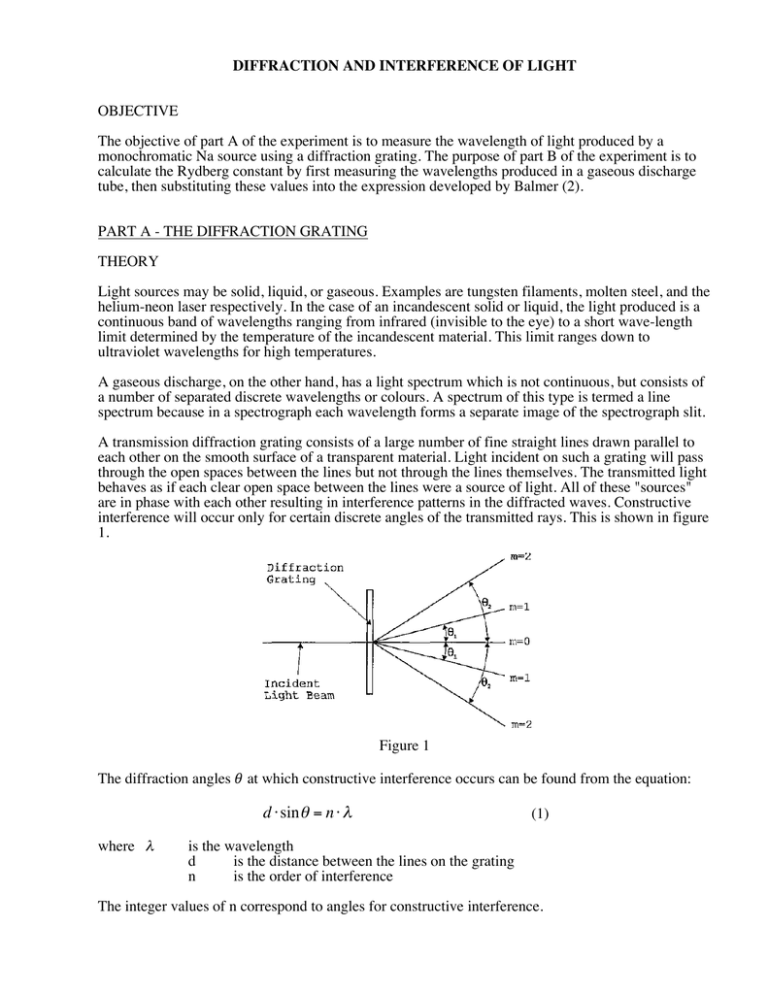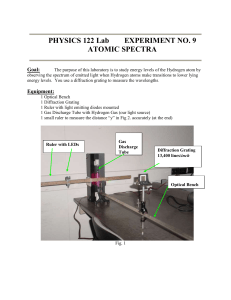d⋅sinθ = n⋅λ - Ryerson Department of Physics
advertisement

DIFFRACTION AND INTERFERENCE OF LIGHT OBJECTIVE The objective of part A of the experiment is to measure the wavelength of light produced by a monochromatic Na source using a diffraction grating. The purpose of part B of the experiment is to calculate the Rydberg constant by first measuring the wavelengths produced in a gaseous discharge tube, then substituting these values into the expression developed by Balmer (2). PART A - THE DIFFRACTION GRATING THEORY Light sources may be solid, liquid, or gaseous. Examples are tungsten filaments, molten steel, and the helium-neon laser respectively. In the case of an incandescent solid or liquid, the light produced is a continuous band of wavelengths ranging from infrared (invisible to the eye) to a short wave-length limit determined by the temperature of the incandescent material. This limit ranges down to ultraviolet wavelengths for high temperatures. A gaseous discharge, on the other hand, has a light spectrum which is not continuous, but consists of a number of separated discrete wavelengths or colours. A spectrum of this type is termed a line spectrum because in a spectrograph each wavelength forms a separate image of the spectrograph slit. A transmission diffraction grating consists of a large number of fine straight lines drawn parallel to each other on the smooth surface of a transparent material. Light incident on such a grating will pass through the open spaces between the lines but not through the lines themselves. The transmitted light behaves as if each clear open space between the lines were a source of light. All of these "sources" are in phase with each other resulting in interference patterns in the diffracted waves. Constructive interference will occur only for certain discrete angles of the transmitted rays. This is shown in figure 1. Figure 1 The diffraction angles 𝜃 at which constructive interference occurs can be found from the equation: d ⋅ sin θ = n ⋅ λ where λ (1) is the wavelength d is the distance between the lines on the grating n is the order of interference The integer values of n correspond to angles for constructive interference. APPARATUS AND PROCEDURE FOR PART A 1. DO NOT CLEAN THE DIFFRACTION GRATING. The lines of the grating are put on the glass with a soft material that will be removed in any attempt to clean them. Let the sodium lamp warm up for about 10 minutes. A mask with a narrow slit cut in it has been attached to the front of the sodium lamp to reduce the size of the light source. Mount the metre stick horizontally in front of and just below the sodium lamp as shown in figure 2. Figure 2 2. Place the diffraction grating in a stand located 0.75 metres in front of the metre stick located near the sodium light. Adjust the diffraction grating so that one can see images of the slit along the metre stick when looking through the grating. Record the positions of the first two images of the slit seen on each side of the centre and also the central image. (Five image positions are to be recorded). 3. Measure the exact distance between the metre stick and the diffraction grating. Determine from the geometry the angle 𝜃 for each image and then use equation (1) to determine the wavelength. Calculate the average wavelength for sodium light and compare with the accepted value λ ≈ 590 nm. PART B - RYDBERG CONSTANT THEORY Every element, when in the gaseous form, emits a characteristic line spectrum; characteristic because the particular wavelengths present are unique to that element. Hydrogen, the simplest element in terms of atomic structure, also has one of the simplest line spectra to analyze mathematically. There are three bright wavelengths in the visible part of the emission spectrum of atomic hydrogen: H (red), H (blue-green), and H (violet). α β γ These lines are related mathematically by the expression developed by Balmer in 1885: %1 1 1 ( = R⋅' 2 − 2 * &2 K ) λ € (2) where • • • • • K = 3 for H -Red (655 nm) K = 4 for H -Blue-green (486 nm) K = 5 for H -Violet (434 nm) λ is the wavelength of H , H , H respectively R is the RYDBERG CONSTANT for hydrogen α β γ α β γ APPARATUS AND PROCEDURE FOR PART B Diffraction Grating Ym Hydrogen Source D θ Observer Metre Stick Figure 3: Set-up of Apparatus for part B 1. Set up the apparatus as shown in Figure 3 with a meter stick held horizontally, immediately in front of the discharge tube. 2. Turn ON the switch of the discharge tube to connect the discharge tube to the high voltage source. The grating should be placed about D = 0.75 metres from the discharge tube and at the same height as the horizontal ruler. The rulings should be vertical and the plane of the grating parallel to the metre stick. Do not touch the ruled surface of the grating. 3. Attach a pointer to the grating holder to provide a reference point at the centre of the grating. 4. With an eye close to the grating look through the grating to read the position Ym of the first (m = 1) and second order (m = 2) bands of the spectrum against the metre stick. The first order violet line is the closest to the centre line. OBSERVATIONS, CALCULATIONS AND RESULTS 1. Record your observations in the following 3 tables and calculate the values of the wavelengths for the three lines and the value of the Rydberg’s Constant in each case: 2. The wavelength can be calculated using the formula: m ⋅ λ = d ⋅ sin θ 3. sinθ may be approximated with tanθ which can found by considering the geometry of Figure 3: € λ= ym D m d⋅ d ⋅ sin θ d ⋅ tan θ = = m m Table No. 1: Observations and Results for the Violet Line € Position Colour wrt the of the central line line Left Violet Right Order of the line in 1 d= the N spectrum (mm) m € Wavelength Ym D (cm) ym D m Average Wavelength Rydberg’s Constant (m-1) d⋅ λ= (cm) λ R= (m) (m) 1 λ $1 1 ' & 2 − 2) %2 K ( € 1 € 2 1 2 Table No. 2: Observations and Results for the Blue-Green Line Position Colour wrt the of the central line line Left BlueGreen Right Order of the line in 1 d= the N spectrum (mm) m € 1 2 1 2 Wavelength Ym D (cm) ym D m Average Wavelength Rydberg’s Constant (m-1) d⋅ λ= (cm) (m) λ R= (m) € € 1 λ $1 1 ' & 2 − 2) %2 K ( Table No. 3: Observations and Results for the Red Line Position Colour wrt the of the central line line Left Red Right Order of the line in 1 d= the N spectrum (mm) 1 m € Wavelength Ym D (cm) (cm) ym D m Average Wavelength Rydberg’s Constant (m-1) d⋅ λ= (m) λ (m) R= 1 λ $1 1 ' & 2 − 2) %2 K ( € 2 € 1 2 4. Based on the values you have found for the wavelengths of the red, blue-green and violet light, you should have calculated the value of the Rydberg constant for each wavelength. Use the values obtained in the previous 3 tables to find your average value and compare this value to the accepted value for the hydrogen: RH = 1.09678 x 107 m-1 DISCUSSION OF RESULTS AND CONCLUSIONS 1. What are the possible sources of error in this experiment and how may they be accounted for? 2. Discuss any results which appear to be in error.
